***This article originally appeared in the December ’22 issue of Animation Magazine (No. 325)***
Disney Animation’s 61st feature release Strange World is inspired by the far-flung tales penned by the likes of Edgar Rice Burroughs, Arthur Conan Doyle and Jules Verne as well as the wide-eyed adventures of classic movies where the protagonists discover a mysterious territory.

“I always loved big adventure stories, the specific kind of story where explorers find a hidden world that was heretofore unknown to them or anybody else,” says the film’s director Don Hall (Big Hero 6, Moana, Raya and the Last Dragon). “King Kong is a good filmic reference that had a group of explorers find a new hidden world. I wanted to evoke that in this movie.”
Strange World follows a diverse family group as they try to deal with their interpersonal baggage and the bizarre things around them. The Clade family is made up of Jaeger (Dennis Quaid), his son Searcher (Jake Gyllenhaal), Searcher’s wife Meridian (Gabrielle Union) and their rebellious teenage boy, Ethan (Jaboukie Young-White). For co-director and writer Qui Nguyen, the push and pull of the family members set against the new vistas they find is part of the secret sauce of the storytelling.
“I was thinking about my kids and what kind of world they’re going to inherit, and what kind of world I inherited from my father,” adds Hall. “I set out to tell an environmental story, but I obviously wanted to do it in a fun way. I wanted to pay homage to the adventure stories that I used to love as a little kid — and still love — where these explorers find a hidden world. A lot of the inspiration for the story came from the pulp magazines that were popular in the turn of the century up until the 1930s and were the precursors to comic books. They were also the inspirations for movies like Raiders of the Lost Ark and Star Wars, to some degree.”

“It’s a movie about legacy, about generations past and the generations future,” says Nguyen, who also co-wrote Disney’s 2020 feature Raya and the Last Dragon. “We had a crew of many generations. It was so beneficial to have people who had been animators with Disney for a long time to just share their own stories, and to talk about what this means for them to work on this film. These would be animators we’d all look toward for a sense of history when we were making the movie. Then you’d have people who were completely new and they’d come in and try some very different things. It helped all of us to have those who were experienced and those who were brand new. In a way, I’m brand new to animation, because I came from the live-action world.”
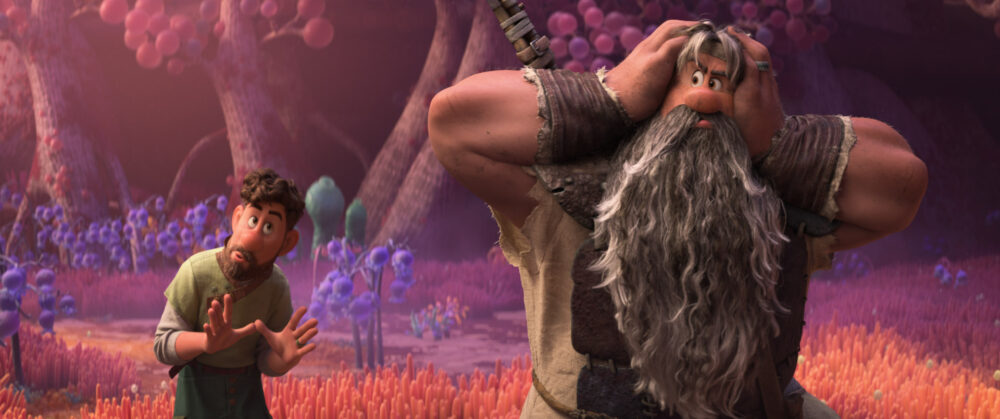
Coloring Outside the Lines
With the family dynamics of the characters set in place, Hall also wanted a color-scape that spoke to his audience. He wanted to distinguish the more familiar world they know and the uncharted place they find right away.
“I wanted the ‘strange world,’ the world of the underground, to feel just wildly different,” explains Hall. “So, very early on, people would be doing [development], and people would paint a landscape in the ‘strange world’ and there’d be some really interesting organic shapes that were really cool and interesting. But the sky is still kind of blue and the grass is kind of green and rocks are kind of brown. That’s okay, but that looks too much like the top world, the world we know. We asked ourselves why those blues and greens and earth tones made the world look familiar.”
After studying the look of those colors, Hall felt the design team needed to chart a new course. “We decided to take those colors off the table and it forced us to make more original, unique choices,” he says. “Also, we assigned the color green to the family. If you look at all the characters, they’re wearing green. Each one is wearing a different shade of green. So, green symbolizes the top world. That’s really important for the audience to have those kinds of visuals. So, we’re coming down into this new world and the colors are completely different.”
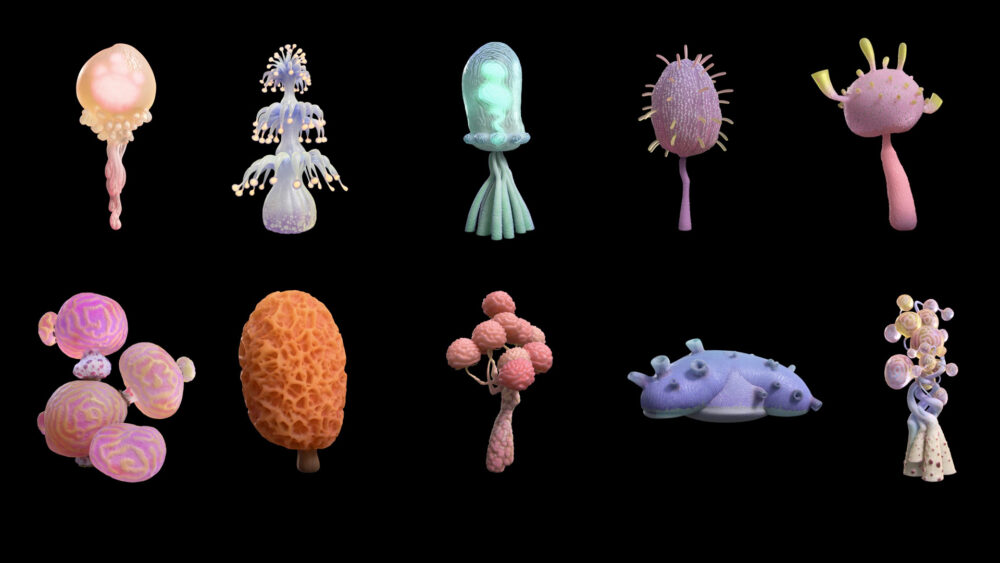
That took them into bold purples, pinks, magentas and oranges. The creatures found by the Clade family also needed to be distinct, but at least a little familiar at the same time. Their movements are sometimes deerlike or they occasionally hop in a bunny-like way, but they still capture the aesthetic of this ‘strange world.’
Hall and his team also looked to the post WWII era Disney animation for ideas for character design — the look of characters in classics like The Legend of Sleepy Hollow and Johnny Appleseed figured prominently during development. These 2D inspirations proved a serious challenge for the CG computer systems used by the animation team.
“It’s really hard to make the computer that does the perfect look of CG create something that’s more a hand-drawn 2D look, because 2D is warm, imperfect and it can be uneven here and there a bit,” says Hall. “But we felt it’s worth it for the kind of classic, old time adventure story we wanted to tell. This look was the right fit so we went for it.”
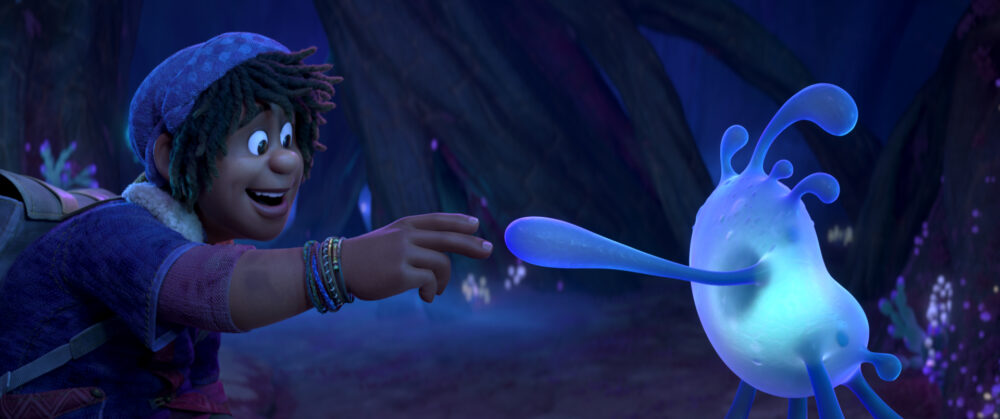
Artistic Exploration
It wasn’t just the look but also the movement that captured the crew when working with their characters. They sometimes exaggerated, but the ways that human characters hopped, skipped and jumped proved valuable for the animators as well.
“I feel like in a lot of ways, a lot of those films, they’re playing around a lot with the character performance,” says Amy Smeed, head of animation. “In addition to Johnny Appleseed and all those post-war characters, there’s a Captain Hook clip that we were referencing when we were working on Strange World, where he’s doing something very physical as part of his performance, but in an imaginative way that captures the audience’s interest.”

Smeed mentions that that the specific movement was something that still made sense for the character. “But the way that character did that jump was in a very interesting way that led us to look at how our characters could move and still be believable to the audience, because we want them to feel the characters are relatable,” she notes. “I think we’re trying to put those choices into this film where people are really thinking about the appeal of that movement. How is the character going to do this thing or that thing? And a lot of it comes down to the breakdowns of how you get from one pose to the next and really making those interesting choices so the audience is surprised and delighted by what they see.”
Hall also took legacy ideas about how to work on a film from his experiences directing Raya and the Last Dragon. He worked on that film through the pandemic and remote work protocols meant he had to place a lot of trust and confidence in his team.
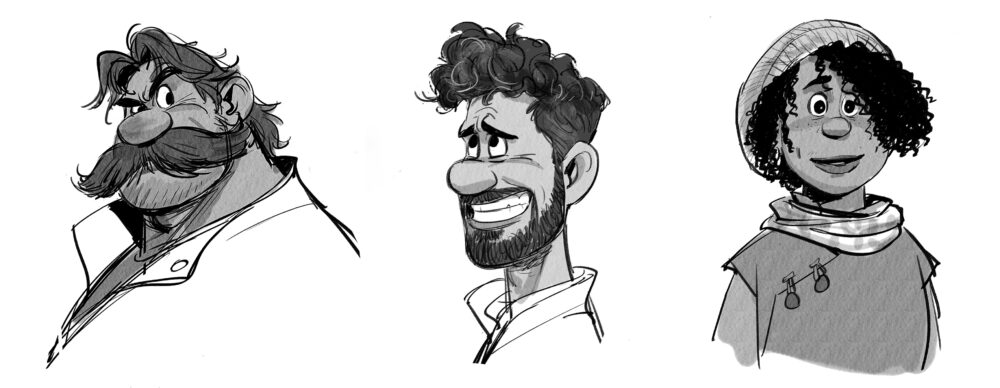
“It might seem like a small thing, but it’s super important and it started with Raya,” says Hall. “We trusted everybody a lot more [with their shots]. A lot of times it’s like you see a first pass and you give your notes and say, okay, we’ll see it later. And then that note gets addressed and it opens up a lot more notes. Instead of that, we trusted the animators on Raya and the dividends that came back were incredible in terms of morale, but also the work. I think that was something that we were witnessed on Raya and expanded that even more on Strange World to encompass the whole movie in every department and the results were similar on this movie.”
“You get everything back exponentially in terms of inspired choices and design,” he concludes. “Whatever vision you had in your head as a director, giving people that takes it into realms you could never have imagined and that are so amazing. The results are taken to the next level, but also the experience of making it is so much more. I hope everybody felt heard and appreciated. When you trust your artists, the end result is they put more of themselves into it and then you get what you saw.”Weird, Wild and Wonderful
The artists at the studio looked at a wide variety of resources to nail the perfect look for the movie. They started with pulp fiction magazines that were published from 1896 to the late 1950s. Production designer Justin Cram notes, “We all had fun designing the different parts of the ‘strange world,’ taking inspiration from those old book covers. Seeing what they thought the future might look like back in that era, whether it was spaceships or aliens. It was a great jumping-off point.”

The team actually crafted three distinctive looks and color palettes: the city of Avalonia, the Clade’s family farm and the strange world. For Avalonia, artists emphasized warm colors, such as white, orange and red.
“We wanted to create a kind of utopia — a warm, nostalgic feeling to emphasize that this is a wonderful culture that everybody enjoys,” says Cram. In the film, Searcher discovers a plant-based power source dubbed “pando,” and Avalonia is featured in both pre-pando and post-pando times. As production designer Mehrdad Isvandi points out, “We show how the city went from single-story buildings to 100-story buildings.”
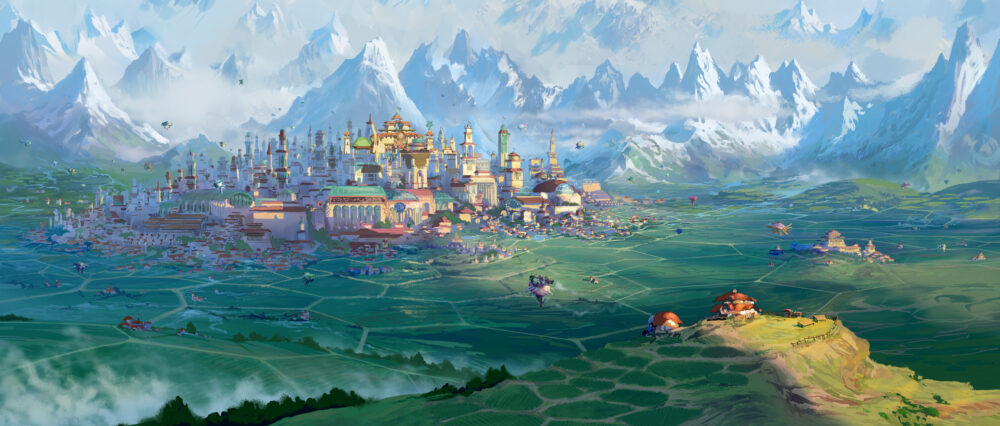
On the Clade family farm, cool colors such as lush greens and blues were dominant. “I was looking at old Kodachrome images from the ’30s and ’40s and trying to connect emotionally because it’s really about the close relationship between Searcher, Ethan and Meridian,” says Cram. “We wanted to make it feel timeless and make it really about the idea of hearth and home.”

In the strange world, the cool colors from Searcher’s farm are used sparingly. As Isvandi explains, “When we get to the strange world, we don’t have any greens except pando,” he says. “We reserved green for pando, and we got away from blue in the sky. Our brain is adjusted to seeing blue skies. Removing that option and thinking of something else to make the image beautiful was an exciting challenge throughout production.”
The environments and creatures within the strange world are so unusual and striking that filmmakers had to be careful not to distract from the main characters at the heart of the film. “If we were looking at specific shots thinking, ‘This world is so amazing and so beautiful, but it compromises a moment between characters,’ then we would pull back,” says Cram. “It’s most important to honor those relationships within the scene. But there are times when the characters are astonished by what they’re seeing. That’s when we can really show off this wondrous environment.”

Making Splat Special
One of the film’s standout characters is a blue, blob-like creature who befriends Ethan and guides the Clades through the mysterious underground world. The creature has a lot of personality, but lacks facial features, so the creative team had to be especially inventive to bring it to life.

“I remember when we saw the character designs of Splat and asked ourselves, ‘How are we going to animate this character?’” says head of animation Amy Smeed. “With Splat in particular, there were a number of animators that were so excited to work on that character. We also had animators who said, this character Splat terrifies me because it can do so many things and be so many things and there are unlimited ways it can move and become other things. We always tend to go for more complicated options as well as out-there designs.
“For a lot of animators, Splat was this opportunity they’d been waiting for — a chance to do something really wild and expressive,” Smeed continues. “There was always a creative decision of what’s going to make the character more appealing, more relatable and more human. But it’s never really about making it simpler! There’s a lot in the timing and posing of the character that sells the emotion — you almost think of it like a puppet.”

Head of animation Justin Sklar adds, “We asked ourselves what if there were 2,000 more of this creature or how can we make Splat even more complicated? We had a lot of conversations about how to keep Splat interesting and fun. Technically, it was extremely complicated to make Splat because there are so many pieces involved, especially since we were wondering about the number of limbs and nubbins. We wanted to do more and more. It was usually about creating poses that were reliably nice and that looked great from moment to moment. It was about making Splat look like something that audiences would love.”

Watch the latest trailer for the movie below:
Disney’s Strange World opens in theaters nationwide on Nov. 23.


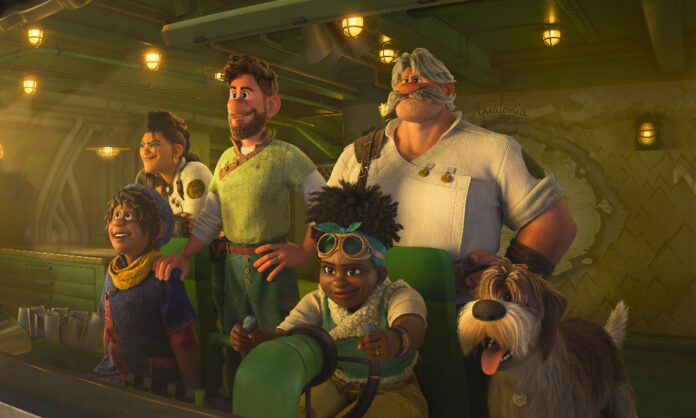


 Win a Funko X Lilo & Stitch Prize Pack!
Win a Funko X Lilo & Stitch Prize Pack!

